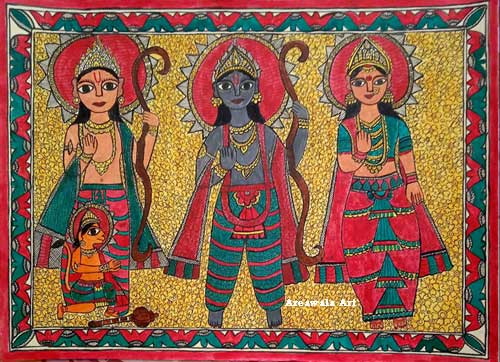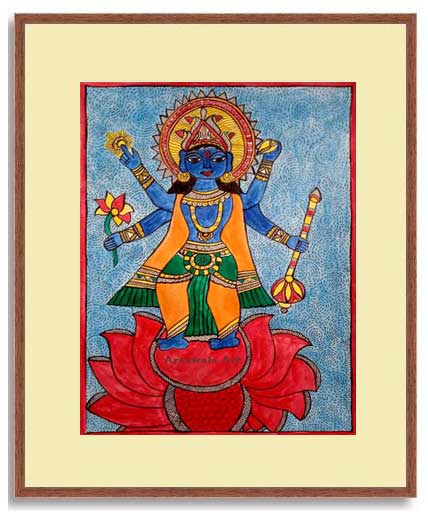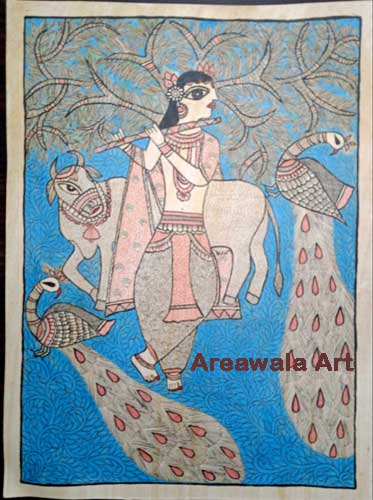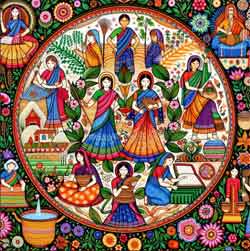Why is Madhubani painting famous? This is a very common question in India and abroad. Madhubani painting, also known as Mithila art, is a distinct art form originating from the Mithila region of Bihar, India, and Nepal. Its vibrant colors, intricate patterns, and rich cultural heritage make it widely recognized and admired.
Madhubani Painting History
First let discuss about history of Madhubani Painting for understanding answer about “Why Madhubani Painting is famous?
Madhubani painting, also known as Mithila art, comes from the Mithila region (Madhubani) of Bihar, India, and Janakpur, Nepal. It has a rich history tied to mythology and tradition. The art form is believed to have started during the Ramayana period when King Janak instructed the people to decorate their homes for the wedding of Lord Ram and Sita.
This art is famous for its intricate patterns and vivid depictions of nature, animals, and religious themes. Primarily created by women, Madhubani paintings use natural dyes and pigments. Every inch of the artwork is filled with detailed designs that tell stories of daily life and spiritual beliefs.
Originally painted on walls and floors, Madhubani art has now spread to canvas, paper, and textiles. This change has allowed it to reach a wider audience and gain international recognition. Its ability to convey complex narratives through bold colors and elaborate patterns sets it apart.
Madhubani painting is a window into Indian culture, offering glimpses of ancient traditions and timeless beauty. As more people worldwide become interested in traditional art, Madhubani painting stands out for its accessibility and visual appeal. Exploring this art form offers a rewarding journey through history, spirituality, and artistic expression.
Join Madhubani Painting Live Class
Simply contact us on 91-9990004135 for join class. You can join from your home and we provide live 1 to 1 live class so success rate is 100%.
6 Main reason Why Madhubani painting is famous?
1. Rich Cultural Heritage

The first factor contributing to Madhubani painting’s popularity is its deep-seated roots in cultural heritage. This art form traces back over 2,500 years and is closely tied to religious events, ceremonies, and epic tales like the Ramayana and Mahabharata. It’s not just an art form—it’s a living testament to the region’s historical and cultural journey.
2. Unique Artistic Style
Madhubani painting stands out for its distinctive style. Characterized by eye-catching geometric patterns, vibrant colors, and intricate depictions of nature, deities, and scenes from daily life, each painting tells a unique story. This aspect alone has made Madhubani painting a favorite among art collectors and enthusiasts. This is original Madhubani Painting by expert native artist.

3. Symbolic Significance

Every element in a Madhubani painting is filled with symbolic meaning, reflecting the philosophy and ethos of the region. Whether it’s the powerful depictions of Hindu deities or the beautifully detailed motifs of flora and fauna, each painting conveys profound messages and beliefs.
4. Use of Natural Materials
Madhubani art embraces eco-friendly practices. The artists use natural pigments and dyes derived from plants and other organic sources. Even the brushes are often crafted from cotton wrapped around bamboo sticks. This sustainable approach to art contributes to its wide appreciation.

5. Empowerment of Women

Traditionally, it was the women of Mithila who practiced and passed down Madhubani painting through generations. This has provided an important source of income and empowerment for many women in the region. The global fame of Madhubani art has given these women artists a platform to showcase their talent and cultural heritage, thus contributing to its fame.
6. UNESCO Recognition

UNESCO’s recognition of the Madhubani railway station, which is beautifully adorned with Madhubani paintings, has added to the art form’s global fame. This initiative not only beautified the station but also helped promote and preserve this cultural heritage.
Tags: #MadhubaniPainting #MithilaArt #IndianArt #CulturalHeritage #MadhubaniPaintingClass
FAQ
What is a Live Madhubani Online 1 to 1 class?
A Live Madhubani Online 1 to 1 class is a personalized, virtual course where you receive one-on-one instruction in the art of Madhubani painting from an experienced teacher. This format allows the tutor to tailor the course content to your skill level and artistic goals, providing individual feedback and guidance throughout the learning process.
How do I sign up for the course?
You can sign up for the course through our website (https://areawala.com). We will contact soon with course details, including the schedule and fees. Please note that seats are limited due to the individualized nature of the course.
I am a complete beginner. Can I still enroll in the class?
Absolutely! Our 1 to 1 Madhubani Painting class is designed to cater to all skill levels, from complete beginners to advanced artists. Our expert tutor will adapt the instruction based on your existing knowledge and skills to ensure a beneficial and enjoyable learning experience.
What if I miss a class?
A5: We understand that circumstances can sometimes prevent you from attending a scheduled class. Will arrange in another day. The key benefit of these 1 to 1 sessions is real-time interaction and feedback, which is not available with recorded sessions.
What materials will I need for the class?
Upon registration, you will receive a list of required materials for the class. Don’t worry if you can’t source everything locally; many items can be found online.
Conclusion:
The fame of Madhubani painting is not solely due to its artistic appeal. It is a harmonious blend of cultural depth, symbolic expression, eco-friendly practices, women empowerment, and international recognition that makes it truly distinctive. Whether you’re an art enthusiast or a casual observer, Madhubani painting has a charm that is hard to ignore.
Remember, art is not just about viewing; it’s about feeling, understanding, and connecting. And Madhubani painting offers just that—a connection with the rich heritage and traditions it represents.
